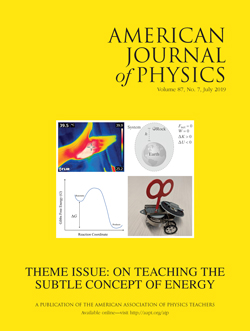 July 2019 Issue,
July 2019 Issue,
Volume 87, No. 7
Theme Issue on Teaching the Subtle Concept of Energy
The 2018 Gordon Research Conference series on Physics Research and Education focused on Energy, one of the cross-cutting concepts identified in the Next Generation Science Standards:1 “The ability to examine, characterize, and model the transfers and cycles of matter and energy is a tool that students can use across virtually all areas of science and engineering.”2 And yet our understanding of this fundamental concept is far from complete. As Richard Feynman noted in a speech to teachers, “Energy is a very subtle concept. It is very, very difficult to get right.”
Guest Editorial
Introduction to the Energy Theme Issue DOI: 10.1119/1.5110871
Papers
Understanding energy as a subtle concept: A model for teaching and learning energy by Eugene Hecht. DOI: 10.1119/1.5109863
A unified, contemporary approach to teaching energy in introductory physics by Ruth Chabay, Bruce Sherwood, and Aaron Titus. DOI: American Journal of Physics 87, 504 (2019); https://doi.org/10.1119/1.5109519. Open Access
Examining physics teacher understanding of systems and the role it plays in supporting student energy reasoning by Lane Seeley, Stamatis Vokos, and Eugenia Etkina. DOI: 10.1119/1.5110663. Open Access
Energy-interaction diagrams: Fostering resources for productive disciplinary engagement with energy by Benedikt W. Harrer. DOI: 10.1119/1.5097391
Development of an interdisciplinary conceptual conservation of energy theme for use in undergraduate physics, chemistry, and biology courses by Nancy L. Donaldson, Lisa K. Felzien, Michael C. Marvin, Joanna J. Cielocha, and Trace Shapiro. DOI: 10.1119/1.5110710
Applying the resources framework of teaching and learning to issues in middle school physics instruction on energy by Michael C. Wittmann, Laura A. Millay, Carolina Alvarado, Levi Lucy, Joshua Medina, and Adam Rogers. DOI: 10.1119/1.5110285
An example of computer modeling to teach energy conservation concepts by Paulo H. Acioli. DOI: 10.1119/1.5110699
Non-science majors learn about heat, temperature, and thermodynamics using the particulate nature of matter and guided-inquiry instruction by Christopher F. Bauer, and Julia Y. K. Chan. DOI: 10.1119/1.5110500
Making energy relevant: The role of free energy in introductory physics by Benjamin D. Geller, and Abigail R. Daane. DOI: 10.1119/1.5110698
Where does energy go when it's “Gone”? Promoting understanding of energy dissipation by Roger G. Tobin, Sara J. Lacy, Sally Crissman, Nick Haddad, Orlala Wentink, and Lane Seeley. DOI: 10.1119/1.5110707
Going through a phase: Infrared cameras in a teaching sequence on evaporation and condensation by Christopher Robin Samuelsson, Maja Elmgren, Charles Xie, and Jesper Haglund. DOI: 10.1119/1.5110665
Improving student understanding of a system of identical particles with a fixed total energy by Christof Keebaugh, Emily Marshman, and Chandralekha Singh. DOI: 10.1119/1.5109862
Improving student understanding of fine structure corrections to the energy spectrum of the hydrogen atom by Christof Keebaugh, Emily Marshman, and Chandralekha Singh. DOI: 10.1119/1.5110473
Book Reviews
BOOK REVIEWS by Robert Socolow American Journal of Physics 87, 606 (2019); https://doi.org/10.1119/1.5110249
The Simple Physics of Energy Use by Michael A. DuVernois. DOI: 10.1119/1.5098457
BOOKS RECEIVED
American Journal of Physics 87, 607 (2019); https://doi.org/10.1119/1.5110293
About AJP
General Information, Resources for Authors, Reviewers, and Readers

